
I am sure we can all agree most of us are not the biggest fans of pain and when it presents itself in our lives, we usually try to resist or avoid it. However, we cannot deny the fact that pain is a critical communication instrument for the body. For example, it signals us to instantly pull our hands back when our fingers accidentally touch boiling water. Pain is designed to command our attention so that we can solve the issue at hand. That being said when the pain is chronic, it is actually more important to not only look at the underlying postural imbalances and lifestyle factors that are contributing to the pain but also at our thoughts about our pain as a strategy for pain management.
The difference between physical and emotional pain

Pain can be broken down into two main categories: physical and emotional.
We have the sensation of physical pain caused by an injury, a postural imbalance, inflammation, surgery or disease and then, we have the thoughts surrounding the pain. So, although the feeling of physical pain is triggered in our body, the experience of pain is ultimately created in the brain.
Emotional pain on the other hand is caused by our thoughts which then manifest themselves in our body through either subtle or intense vibrations that lead us to experience unpleasant feelings in different parts of the body. For example, when we feel extremely anxious our chest might tighten and our hands may start to sweat. So instead of originating from the body, emotional pain arises from our mind.
Where and how the body interprets pain
So there is a part in the brain called the anterior cingulate cortex where the brain registers pain as unpleasant. Research has repeatedly provided evidence to illustrate that people who have an impaired anterior cingulate cortex encounter physical pain (e.g knee fracture), but do not perceive the experience to be a painful one1. For instance, when where are in physical pain and the doctor gives us morphine what the drug does is that it simply changes the way we perceive the feeling of pain. This does not mean the pain is not there, it just shows that our brain is perceiving it as harmless. Simply put physical pain is just the mind rendering an event as unpleasant which can be mediated by our thoughts.
It is also interesting to note that the same areas of the brain get activated when we feel physical and emotional pain. Here are some studies that support this:
• A 2011 study demonstrated the neural overlap between the emotional pain felt from social rejection and any kind of physical pain in the brain by comparing both conditions in the same individuals using functional magnetic resonance imaging - a tool used to measure brain activity by detecting changes associated with blood flow2.
• A 2017 study showed that physical pain and depression share similar brain regions and neurological function systems3.
• A 2012 study showed a significant increase in the activity in the anterior cingulate cortex from participants who felt upset from being socially excluded4.

These findings highlight that emotional and physical pain are similar beyond just the fact that they are both traumatic but they share a common neural overlap too.
Now that we've understood that all pain, be it physical or emotional, is created in the brain. It helps us recognise that all treatment for pain has to include a psychological management component.
How to manage physical and emotional pain
Now that we've understood that all pain, be it physical or emotional, is created in the brain. This helps us recognise that we can effectively manage our experience of pain is via our thinking because the thoughts that we have about our pain can make us feel either:
1. neutral,
2. positive or,
3. negative.
Accept pain and heal yourself
Pain x Resistance = Suffering
If you think back to the most unpleasant experiences in your life. Were they not the ones where you resisted pain or avoided feeling negative emotions that bubbled into your consciousness?
Pain x Acceptance = Freedom
Accepting it and allowing it makes us more comfortable with it and less likely to avoid, resist, or buffer against it. What feels so interesting about accepting pain is once we've accepted it, we're not in such a hurry to change it. People who are in such a huge hurry to get out of pain overly stressing themselves out and create a lot of tension on top of the physical and emotional pain that they're already having, which of course, makes it worse.

Once we have established this, we can move on to make the next paradigm shift and that is that ‘pain is harmless’. The more we can see it as harmless, the less it hurts. In this way, we are giving the pain less power over our wellbeing.
Thoughts for optimal pain management
As we have previously discussed all pain, be it physical or emotional, is just a reaction created in the brain and so how we think about our pain can truly make a difference in the way we experience it. So, here are some affirmations/phrases you can say to yourself (in your mind or out loud, whichever works best for you) when you are in pain:
“I accept this pain.”
“I release myself of the need to change this present moment.”
“I accept myself.”
"This is pain."
"This pain is tolerable.”
“This pain is harmless.”
“This pain is momentary. I am ok. I am safe.”
"I feel safe and secure to move towards the pain."
“I am willing to be at peace with how I am currently feeling.”
“I let go of my perceived pain.”
“I find it easy to relax.”
"This pain is my teacher and I can learn from it."
We’d strongly recommend you do at least 10 to 20 rounds of deep belly breathing before saying these affirmations to help your heart rate slow down to generate sensations of calmness and inner peace.
Having said all of this with chronic physical pain, it is still very important to eliminate the root causes of the pain that can be normally linked to poor posture, injury or unhealthy lifestyle choices. If you are suffering from chronic back pain and you'd like to understand the postural and lifestyle factors that are causing the pain, click here. For those suffering from chronic neck and shoulder pain, click here.
Wrapping up: practice makes perfect
You’ve most probably heard the saying that “practice makes perfect,” and it is generally true. So if you have been suffering from chronic pain and any other type of emotional pain then, overtime with practice you’ll learn how to be present with your pain, feel and accept it for what it is. This process is not going to be easy because as humans we instinctively want to seek pleasure and avoid pain. Hence, the thoughts that will automatically appear in our brain will not be in our favour when we are learning to try and make this paradigm shift of accepting pain as opposed to resisting it. So be kind, forgiving and compassionate to yourself during your re-training period but also persistent because although pain is inevitable, suffering is optional.
To your health, happiness and longevity,
The Levitise Team
P.S. If you love this blog post then do check out our fortnightly newsletter where you'll get the freshest content on health, nutrition and fitness delivered straight to your inbox. Don't miss out and sign up here with just your name and email.
1. https://www.ncbi.nlm.nih.gov/pmc/articles/PMC1571498/#b31
2. https://www.pnas.org/content/108/15/6270.long


Write a comment